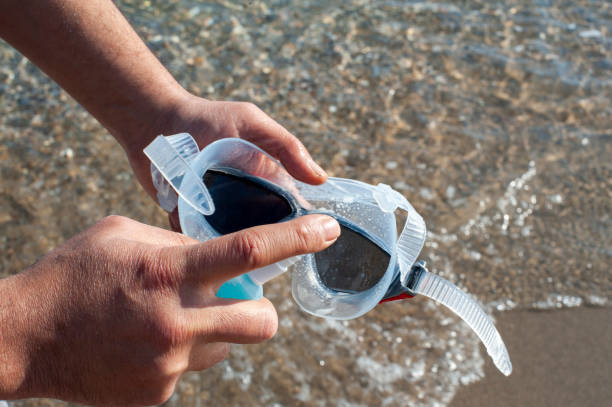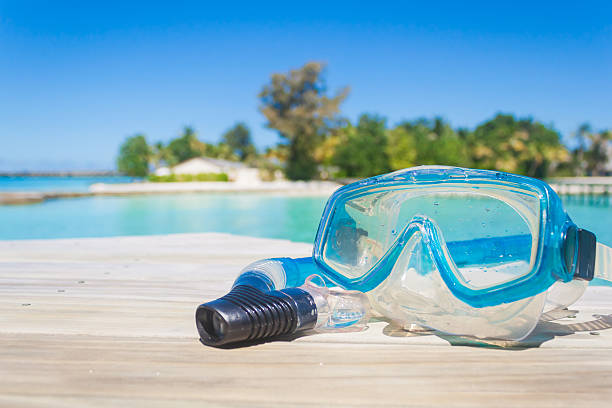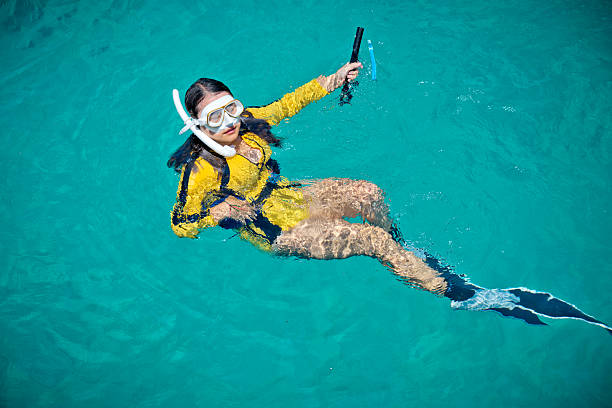Sumergirse en las profundidades del océano es una emocionante exploración tanto del yo como del entorno marino. Esta fascinante aventura trasciende la simple apreciación de la serena belleza del mundo submarino. Enfatiza la importancia de comprender las capacidades y limitaciones del cuerpo humano al sumergirse. Por ello, este artículo busca ofrecer una exposición exhaustiva del tema, destacando los principios básicos y los protocolos de seguridad.
¿Hasta qué profundidad puede bucear un humano?

¿A qué profundidad se puede bucear en apnea? El buceo en apnea se centra en la libertad del cuerpo humano sumergido. El límite de profundidad promedio para un atleta recreativo se encuentra entre 30 a 40 pies (9 a 12 metros)Sin embargo, mediante el perfeccionamiento de la técnica y el entrenamiento de la apnea, las personas pueden superar estas cifras. El dominio de las técnicas de ecualización, las rutinas de yoga disciplinadas y los regímenes de ejercicio específicos pueden aumentar el potencial humano en este sentido.
¿Qué es el buceo?

Por definición, el buceo es la práctica de descender bajo la superficie del agua para interactuar con el medio acuático. Existen varios tipos de buceo, definidos según el contexto y el equipo utilizado, desde submarinismo, con tanques de oxígeno atados a la espalda, para buceo libre, que depende únicamente de la capacidad de contener la respiración. Buceo recreativo, buceo técnico, buceo en cuevas y buceo comercial. forma parte del amplio espectro.
Cada tipo de buceo requiere un equipo específico. Estándar equipo de buceo incluye un máscara de buceo Para la visibilidad, aletas para la navegación, un traje de exposición para regular la temperatura y un dispositivo de control de flotabilidad para la gestión de la profundidad. En el buceo, esto incluye aparatos de respiración como reguladores y ordenadores de buceo.
Comprender los límites de profundidad humanos

Los factores fisiológicos y psicológicos determinan los límites del descenso humano a grandes profundidades bajo el agua. El aumento de la presión del agua al descender influye en el control de la flotabilidad y plantea varios desafíos fisiológicos, entre ellos: narcosis por nitrógeno y enfermedad por descompresión—afecciones causadas por la acumulación y liberación de gases en el cuerpo bajo cambios de presión. El estado psicológico del buceador, como el pánico, el miedo o la confusión, también puede contribuir a los accidentes de buceo.
Buceo vs. Apnea

Hay una marcado contraste entre el buceo y el buceo libre más allá de la visible ausencia de equipamiento en este último. buceadores Pueden permanecer bajo el agua durante más tiempo, explorar mayores profundidades y llevar más equipo, pero requieren una gran inversión financiera en equipos y capacitación técnica.
Buceo librePor otro lado, el buceo en apnea es una celebración del instinto y el potencial humano natural, ofreciendo una interacción más íntima y tranquila con la vida marina, sin el ruido de las burbujas. Sin embargo, requiere una condición física excepcional, disciplina y una mayor tolerancia al riesgo debido a los riesgos inherentes. Si quieres saber más sobre buceo, tenemos una entrada informativa en nuestro blog. Todo lo que necesitas saber sobre el buceo en apnea que explora el tema en detalle.
¿Qué tan profundo puedes bucear con equipo de buceo?

Por lo general, el buceo recreativo se ajusta a un límite de profundidad recomendado de 130 pies (40 metros)Para los buzos técnicos que han recibido entrenamiento, equipo y procedimientos especiales, la profundidad puede extenderse hasta 300 pies (90 metros)Y aún más. Sin embargo, las inmersiones a más de 40 metros (130 pies) de profundidad se consideran muy arriesgadas y no se recomiendan.
Récord mundial de profundidad de inmersión libre

En el ámbito del buceo en apnea, los récords mundiales son la cumbre de la destreza submarina humana. El récord actual de inmersión en apnea más profunda, en categoría masculina, se sitúa en una asombrosa cifra. 702 pies (214 metros), en poder de Herbert Nitsch, apropiadamente apodado "el hombre más profundo de la Tierra".
El logro de Nitsch inspira a los aspirantes a buceadores libres de todo el mundo, demostrando el inmenso potencial del cuerpo humano para superar sus limitaciones. Sin embargo, es fundamental recordar que los intentos de récord mundial superan los límites de la capacidad humana y solo deben ser llevados a cabo por personas altamente capacitadas y con experiencia, con un sólido conocimiento de los riesgos que conllevan.
Medidas de seguridad para el buceo profundo

En el buceo profundo, los protocolos de seguridad son fundamentales para salvaguardar el bienestar de los buceadores. La exploración a mayores profundidades requiere equipo y entrenamiento específicos para mitigar posibles riesgos.
Importancia de los protocolos de seguridad en el buceo profundo
El buceo profundo presenta desafíos únicos y riesgos potenciales que deben abordarse mediante protocolos de seguridad establecidos. Estos protocolos sirven de base para prácticas seguras y ayudan a los buceadores a tomar decisiones informadas durante su experiencia submarina. Al adherirse a estos protocolos, los buceadores pueden minimizar los riesgos asociados con la mayor profundidad y mejorar su seguridad general.
Equipo y entrenamiento necesarios para bucear a mayores profundidades
Bucear a mayores profundidades requiere equipo especializado diseñado para soportar el aumento de presión y abordar las posibles complicaciones que puedan surgir. Los buceadores técnicos, por ejemplo, utilizan equipos de buceo avanzados como los rebreathers, que reciclan el aire exhalado para proporcionar un suministro continuo de oxígeno. Estos equipos no solo prolongan el tiempo en el fondo, sino que también permiten paradas de descompresión más seguras durante el ascenso. Normalmente, los buceadores profesionales... fabricantes de equipos de snorkel y apnea Proporcionaremos equipos que se ajusten a las necesidades del mercado. Haga clic para obtener más información.
Además de equipo especializado, el buceo profundo requiere una formación exhaustiva. Los buceadores deben realizar cursos completos y adquirir experiencia en técnicas como la gestión de gases, los procedimientos de descompresión y las estrategias de respuesta ante emergencias. Al adquirir los conocimientos y las habilidades necesarias, los buceadores pueden afrontar con confianza los desafíos asociados a las grandes profundidades.
Riesgos y precauciones del buceo profundo
Si bien el atractivo de explorar las profundidades es innegable, es fundamental reconocer y mitigar los riesgos que conlleva el buceo profundo. El aumento de la profundidad conlleva peligros potenciales como la narcosis por nitrógeno, que puede afectar el juicio y la coordinación. La enfermedad por descompresión, también conocida como síndrome de descompresión, es una afección que puede ocurrir al ascender demasiado rápido, lo que provoca la formación de burbujas de nitrógeno en el torrente sanguíneo.
Para mitigar estos riesgos, los buceadores deben cumplir estrictamente con los programas de descompresión durante el ascenso, permitiendo que sus cuerpos liberen gradualmente el exceso de nitrógeno. El entrenamiento regular, la práctica y el mantenimiento de una condición física adecuada son esenciales para reducir los riesgos asociados con el buceo profundo. Además, la comunicación constante y la planificación de las inmersiones entre compañeros garantizan una respuesta eficiente ante cualquier imprevisto.
Conclusión
En esta emocionante aventura del buceo, comprender las limitaciones de las capacidades humanas bajo el agua es crucial. Tanto si eres un buceador experimentado como si eres un principiante con ganas de explorar las profundidades del océano, recuerda las reglas fundamentales del buceo: planifica tu inmersión, bucea según tu plan y nunca excedas tu nivel de entrenamiento. El cuerpo humano exhibe una adaptabilidad fenomenal, lo que hace del buceo profundo una perspectiva tentadora. Sin embargo, consuélate sabiendo que el fascinante encanto de la vida submarina no se limita a las grandes profundidades, sino que comienza a tan solo unos metros bajo las olas. Disfruta explorando estas maravillas acuáticas mientras observas los protocolos de seguridad y respetas tus limitaciones personales.



